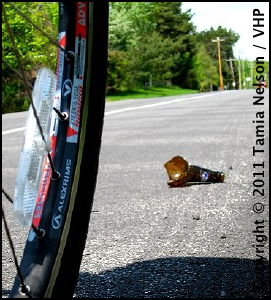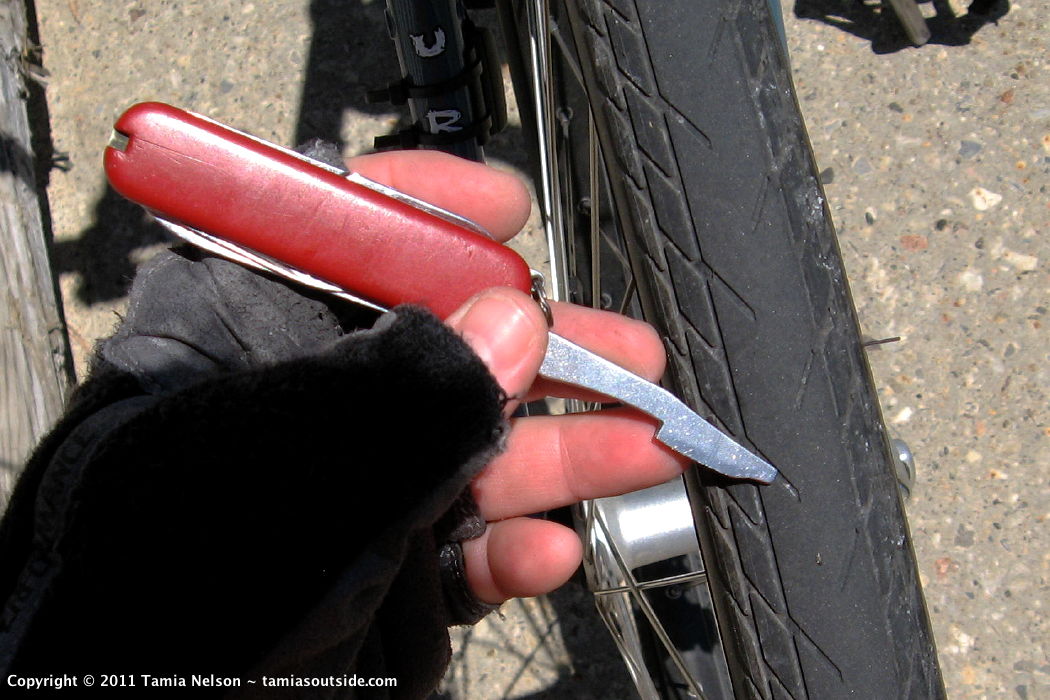Are your tires letting you down more often than you think they should? Then you’ll want to read this.
______________________________
by Tamia Nelson | August 17, 2013

The bicycle started out as a rich man’s toy. Before too many years had passed, however, it evolved into efficient and economical transport for the working man. The pneumatic tire was one of the innovations that made this transformation possible. A very good thing, in other words. (Then again, it also helped to pave the way for the automobile. The jury’s still out on that.) Of course, everything comes at price. The pneumatic tire gave us low rolling resistance and an easier, less jarring ride on broken pavement. But it also gave us flats. And that problem is still with us today, more than a century after Michelin began selling the first practical pneumatic bicycle tires. Despite the recent proliferation of sealants, puncture guards, and tire liners, the diminuendo PPPFFFFFTTTT of a rapidly deflating tire remains a recurring coda in the music of the road.
Sometimes, however, a tire gives ground by inches, losing air gradually over a period of days, unnoticed until it suddenly parts company from the rim in a hard turn. The end result is the same. You feel let down. And for good reason. That’s exactly what’s happened. Then begins the frustrating business of locating the cause, removing the tire from the rim, replacing (or repairing) the punctured tube, and pumping it up again. All of which has to be done before you can continue on your way to your destination. It really is a letdown. Your newly begrimed hands and sweat-soaked clothes won’t do much to improve your mood, either.
Clearly, then, prevention is better than cure, but in a country like the United States, where tossing empty beer bottles from speeding cars is a much-cherished national tradition, that’s easier said than done. A sharp eye and quick reflexes can sometimes save you. Often, however, the threat to your tube’s integrity is an all-but-invisible shard of glass, a short length of wire, or a tiny thorn. In such cases, you may enjoy a short grace period, during which the offending object burrows down through the tire’s tread and casing. Which is why it pays to check your tires after every ride — and during breaks on longer rides. Is this a nuisance? Yes. But it’s not as much of a nuisance as fixing a flat at the edge of busy highway in the pouring rain.
Eyeballing Your Tires It really isn’t hard to do. In an ideal world, you’d always be able to put your bike up on a workstand, in a place with good light. But you can get by with a two-legged kickstand on the road, using a headlamp to brighten the scene if the sun isn’t cooperating. Or simply lift each wheel in turn while squatting at either end of your bike. The inspection drill itself is easy. Spin the wheel slowly, starting near the valve. (Unless you like going in endless circles, you’ll want a reference point to mark your starting point.) Now eyeball the tread and sidewalls closely for new cuts, bulges, or areas showing excessive wear. Any bulge deserves immediate attention. It could just mean that the bead isn’t properly seated. In which case the remedy is simple: let most of the air out of the tire, seat the bead correctly, and then pump the tire up again, checking periodically to make sure that the bead stays where it belongs. Most likely, though a bulge is a sign that the tire’s casing is damaged. A tire boot may get you through till day’s end, but you’ll want to replace the tire at the earliest opportunity. This is also the only remedy for a tire with tread that’s worn down to the cord.
Luckily, bulging tires are rare. You’re much more likely to find tiny cuts in the tread. Most of these are nothing more than that: cuts. But now and then a cut conceals something sinister — the shard of glass I mentioned earlier, or a fragment of sharp metal. Or even a thorn. You won’t know unless you look. And that means spreading the cut open. Your fingers will do for larger cuts, but small cuts call for special tools. The blunt end of the orange peeler on a Swiss Army knife works well, as does the tip of the knife’s nail file. Either of these will open the smallest cut for inspection. They also double as probes and extractors, making it easy to remove any sharp shard before it machetes its way down through the tire’s casing. WARNING! Sometimes these tiny bits of glass and metal rocket out of their hidey-holes when struck by a probe. After one bounced off my cheek, I made sure I wore glasses when inspecting my tires. Learn from my mistake. Don’t wait for a shard to bounce off your cheek — or, worse yet, embed itself in your cornea. Wear glasses!
On most days, it will take you only a minute or two to eyeball your tires and probe any new cuts. Squeeze both tires while you’re at it. Once you know how a properly inflated tire feels, it’s easy to spot one that’s going soft on you. Then do it again before your next ride. And be sure to top up your tires with a pump every week, as well — more often during the shoulder seasons, when temperatures fluctuate dramatically, cold one day, hot the next. Use a gauge to get the pressure just right when you top up, too. That’s the best way to get a feel for proper inflation.

Will these simple exercises guarantee that your tires will never let you down? No. So long as boyz break beer bottles and hedges shed thorns, the occasional flat is a fact of life for cyclists. But a few minutes each day spent eyeballing your tires will minimize the amount of time you spend fixing flats at the side of the road. Believe me, it’s worth it.

